R. Mark Liebenow's Blog: Nature, Grief, and Laughter, page 3
April 1, 2025
Gilda and Cancer
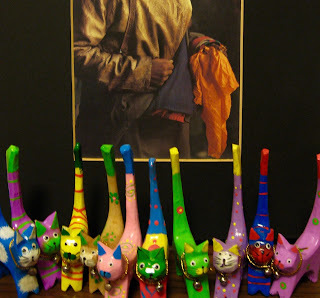
Holy Fools Day
Today, April 1, I honor one of the saints of laughter – Gilda Radner, who looked for humor in the midst of her cancer, and found it. She bore witness to the power of comedy, and is one of my Holy Fools.
You probably remember Gilda from Saturday Night Live. She died of ovarian cancer in 1989 at age 42, and her husband Gene Wilder was devastated. A speaker from Gilda’s Club in Chicago met with my cancer support group and talked about how they are helping people navigate through their cancer. The Club was created to continue the hope and support that Gilda found in The Wellness Community in Santa Monica as she went through treatments. Her book It’s Always Something records her journey though surgery and chemotherapy, and it was published shortly before her death.
Gilda noticed there was a problem when her fatigue wouldn’t go away. She went to multiple doctors who misdiagnosed her. Eventually she found a doctor who knew what was going on and began therapy. Because of Cancer Research, treatments for ovarian and other cancers have improved significantly since then with the development of targeting therapies like PARP inhibitors and antibody-drug conjugates.Gilda said, “I just didn’t want to be in tragedy …. I just wanted to be what I am – a comedienne, a jester.” “If I’m gonna have it, I’ve gotta find out what could be funny about it. … My life had made me funny and cancer wasn’t going to change that.”
Most of us with cancer are reluctant to appear angry or depressed in front of others. I wanted to be aware of every emotion I was feeling so that I could work with it and so that the people I leaned on for support would know how to help.
I also wanted to share my emotions honestly to let others who were dealing with cancer realize that whatever emotions they were feeling were valid, that this is how it feels to have cancer, and these are some of the thoughts that keep running through your mind.
Like Gilda, I didn’t want to be “the one with cancer” but the one who was coping with cancer as a challenge. Gilda said, “Once you have cancer you live on a tightrope. You live from day to day.”
One day Gilda wondered, “How many times does humor come into the business of oncology and chemotherapy?” She thought her doctors and nurses needed some humor, so she made a video of her playing tennis and saying how chemo had improved her game, knowing that the chemo hadn’t helped her at all and she still wasn’t good at it. Without the sound working, she said the it was Chaplinesque funny, but I imagine her looking like another holy fool, Buster Keaton, as she served poorly and fell down on the court trying to catch up with the balls.
At The Wellness Community, the cancer patients often held parties with each other and danced to celebrate being alive because they wanted to affirm the presence of life.
Jokes are still funny when we have cancer, and we need to let ourselves laugh at them, and we need to continue to celebrate the good things that come our way each day. Humor releases the tension of cancer treatments and softens the terror that builds up within us. It helps us breathe with hope.
Gilda Radner (June 28, 1946 – May 20, 1989)
March 22, 2025
Chautauqua Interview
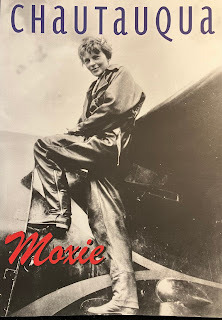
Some good news, which all of us desperately need. The interview on writing that I did with the Chautauqua Literary Journal went up on their website, along with three of the essays that I’ve published with them over the years. It’s a new series the journal is starting called Look Back. Links to the three essays appear at the end of the interview.
https://chautauquajournal.wixsite.com...
February 27, 2025
Famous Prostate Men

Every cancer is traumatic, but when you get prostate or breast cancer, it really messes with your self-esteem.
Men get prostate cancer as frequently as women get breast cancer, yet I’m personally aware of only two men who’ve been treated for prostate cancer, while I know a bunch of women who’ve had breast cancer. I think the reason is that women share their struggles more often.
As I do research to understand my cancer, the names of famous men keep showing up. Most of the names are of those who did not survive. I suspect that those who lived chose to keep their news private. The famous who died, and had their obits in the newspaper, didn’t have a choice. There are also countless unknown men whose deaths never made the headlines.I recognize the names of entertainers and politicians, of course, but also of athletes who were in great physical shape, men like Ty Cobb, Steve Garvey, Ryne Sandberg, and Wade Boggs. Being rich, being famous, being in shape does not exempt you from getting cancer.
Wade Boggs is an interesting case. In September 2024, he said his cancer tested at Gleason 7, which indicates intermediate risk and was probably Stage 2. This month, five months later, he says he is cancer free. I’m guessing he had surgical removal. While his cancer is gone, he’s probably dealing with urinary and ED aftereffects. I’m glad that he could be diagnosed and treated so quickly. It took me seven months just to move through urology and get to oncology, and almost a year before doctors started to kill my cancer with radiation. Two and a half years after I was diagnosed, I’m still waiting for my doctors to say my cancer is gone. Maybe because my cancer is Stage 3, higher risk, and prone to misbehave, my doctors are cautious about making any pronouncements.
These are some of the famous men who died, with other details I found. You will recognize many of the names: J.G. Ballard died in 2009, Bill Bixby age 59, Stokely Carmichael, Winston Churchill, Eldridge Cleaver, Gary Cooper, Gregory Corso, Vince Flynn, (diagnosed in 2010 with stage 3 and a rare form of metastasis, died 2013, age 47), Dan Fogelberg from Peoria died in 2007 at age 56, Dennis Hopper, Langston Hughes, William Hurt (diagnosed in 2012, died 2022. He said in 2018 that it had metastasized into his bones), Christopher Isherwood, Dexter Scott King, Barry Lopez (nature writer, diagnosed in 2013, died 2020 of metastatic cancer, age 75), Pablo Neruda (died 1973 of advanced prostate cancer), Sidney Poitier, Desmond Tutu, Robert Penn Warren, Jun’ichi Watanabe, Walter Winchell, Ludwig Wittgenstein, and Frank Zappa (diagnosed in 1990, died 1993, age 52, of metastatic cancer).
These are some of the famous men who survived: Harry Belafonte had surgical removal, Jerry Brown, Warren Buffett caught his early and had radiation, Robert De Niro found his cancer during a routine PSA at age 60, Stephen Fry (who has a Gleason 9 out of 10), Elton John, who discovered it early and had surgery, John Kerry, Phil Lesh, Nelson Mandela who was diagnosed at age 83, had radiation, and lived twelve more years, Ian McKellen, Ryan O’Neal, Arnold Palmer, Mandy Patinkin, Sidney Poitier, Colin Powell, Al Roker, Ben Stiller who discovered it early via the PSA, Joe Torre, and Andrew Lloyd Webber.
February 1, 2025
The Cancer Poetry of Katie Farris
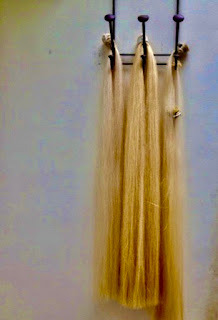
Katie Farris, Standing in the Forest of Being Alive, Alice James Books, 2023
Katie Farris showed up on my doorstep the other day, with poetry she’d written about her experiences with Stage 3 breast cancer. It’s about time, I thought. Elizabeth Boleman-Herring put up a post about Farris and her book. It intrigued me enough to order a copy.
I was thankful because I’ve been dealing with Stage 3b prostate cancer that expanded locally for over two years, and my emotions and struggles have been all over the place. It’s a reciprocal cancer – 1 in 8 American women get breast cancer while 1 in 8 American men get prostate cancer.
I was tired of paging through the pamphlets my oncologist gave me that describes the life expectancies for every stage of the cancer, along with what treatments are usually tried, although it noted that everyone is different so they might not work in my case. What I wanted to read was not more grim statistics but the emotions of having cancer and finding hope as you go through the treatments. I wanted honesty and courage and insights. I wanted companionship with someone else who is walking this path day after day and is finding ways to survive, someone who knows that fear about dying, like cancer, “has teeth and eats.”
The poems are moving because they dare to speak the horror, the moments of despair when a test result indicates that chemo is going to be needed, or surgeons are going to have to go back in and cut out more flesh. They hold the anguish and terror of wondering if you are going to survive or need to begin packing your life away. They are direct, and this is what I need cancer poems to be.
I’ve been writing my own poems and essays about my cancer treatments and revising them through my writing group. Katie’s poems challenge me to be as blunt as the radiation and chemical therapies, the bone scans, PET scans, the anti-hormone shots, the loss of your body’s privacy, the worry about “uncertain death and certain damage.”
She includes poems about her loss of self-esteem as her long hair comes off, her muscles disappear, and she is trying to reclaim her body’s physical need to be touched gently and loved. There are poems about her relationship with her husband because cancer doesn’t just concern the patient, it also affects the people who care about us. Our relationship with our partner continues to evolve as we both try to cope with what the disease is doing now, what it might do in the future, and how we might have to rearrange our lives to handle the changes. There are poems about social issues, and rightly so, because the world does not stop moving and falling apart simply because our life has been paused by the unending tests and treatments.
Tonight, two of her poems speak to me as I probe the darkness for meaning. “Why Write Love Poetry in a Burning World” and “The Wheel” both talk about looking for what isn’t hell when you are in the midst of the hell that is cancer. It is hard to feel joy and celebrate life when we are exhausted and our bodies are nauseous and battered by cancer. I need to “train” myself to look for what is still good and dig it out. Like Katie, what has helped me hold on to who I am as my body is being pummeled is walking in the forest behind my house and rooting myself into nature.
There are probably other poetry books that people have written about their cancer, and I confess that I haven’t gone looking for them. I treasure Julie Hungiville Lemay’s book The Echo of Ice Letting Go (2017) and Ilyse Kusnetz’s book Angel Bones (2019) as both women confronted the cancers that would take their lives. Both books were suggested by friends. Katie’s poems showed up on my doorstep at a time when I needed words to hold me in place because I didn’t know what my cancer was doing.
My one criticism is that I wanted more poems about her cancer journey. I imagine that she has many more that did not make this book. Perhaps the rest will appear in her next one.
January 16, 2025
Ringing the Bell
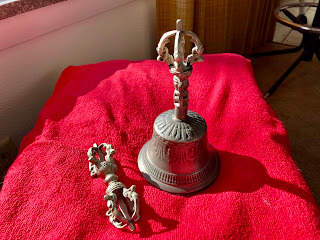
There’s a tradition with cancer that you ring a large brass bell when the doctors say you are cured. It’s a tradition that is thought to have begun in 1996. A great deal of meaning is in this moment because it signals that you can return to your life. It’s also a moment of intense gratitude for the nurses and doctors who have cared for you and worked hard to free you of cancer.In recent years, people have been rethinking the tradition. Lindsey Zinck, at Penn Medicine, says that patients who have metastatic cancer, and are going to be on maintenance therapy for the rest of their shortened lives, will never have this moment when they can say their cancer is gone. While they feel joy hearing the bell ring for cancer friends they’ve come to know and care about, it’s hard on them. Could the ringing mean more? Zinck thinks so.
The ritual could also be used to mark the completion of an important cancer milestone, like the end of a round of chemo or the completion of weeks of daily radiation. Even if you know you still have other treatments ahead of you, ringing the bell affirms that you have made it through this trauma. You have endured, and this is to be celebrated. Cancer is hard, and treatments tend to go on for a long time. I think we should celebrate every good blood test, every clear scan, every day that we feel surprisingly good. I want to hear bells ringing all the time.
I didn’t ring the bell at the end of my radiation treatments because I wanted to know for sure that my cancer was gone. Later I found out there is no such test. I also wanted my nurses and doctors with me when I rang the six-inch bell in the hallway so that I could thank them. I didn’t ring my bell, and wish I had, if only to signal to my friends in the waiting room to stay strong.
Compassion is needed with cancer. Loads of it. For yourself, of course, as you find ways to nurture your mind, body, and soul in the midst of the struggles, and also in your support of the cancer patients you’ve met. We have needed the wisdom and compassion of the nurses and doctors who have cared for us. Do they have a bell that they ring every time they tell patients that they don’t have to come back for a year?
When my doctors finally say that my cancer is gone, I will let out one of Walt Whitman’s “barbaric yawps” of joy, and I ring the first bell I can find, and I will ring it loud, and I will ring it long! And then I will cry.
January 7, 2025
Finding Out You Have Cancer

The tests and scans.
The difficulty in treating cancer is in determining where it is, how much there is, and what kind of cancer cell is causing a ruckus.
Finding out if you have cancer is the first step, and the sooner you figure this out, the better your outcome will be. So, if your primary doctor suggests you get cancer screening for some part your body, take them up on it. I had no symptoms of prostate cancer, but my annual PSA test with my primary revealed a problem.
After the doctor determines you have cancer, often through a mammogram for breast cancer for women or a PSA blood test for prostate cancer for men, you will go through a variety of tests and scans to determine the where, the what, and the how much, like the MRI, CT, bone, and PET.For men with prostate cancer, if the PSA blood test shows something, then the doctor does a DRE (digital rectal exam), followed by a biopsy of tissue from the prostate to determine the aggressiveness and distribution of the cancer. Then they will probably do a PSMA-PET scan to locate the cancer’s exact location. Is it still contained within the prostate, or has it seeped out into the seminal vesicles, lymph nodes, or bones?
After all your treatments are done that are designed to kill the cancer (surgery, radiation, hormone therapy, chemotherapy), you understandably want to know if you’re cured. Here’s the thing. The doctors don’t know. They do not have a test or scan that is precise enough to locate individual cancer cells, so you have to wait to see if anything starts growing again. For men with prostate cancer, they will need two years of good PSA results, done every three months, before doctors will say you’re cured.
I’m no longer sure that “cure” is the right word to use. The more I read, the more it seems that once you get cancer, cancer will always be in your thoughts, even if doctors say you’re cured, because prostate cancer comes back in 30% of prostate men who have been successfully treated. Recurrence rates for breast cancer are similar. “Remission” might be a more accurate word, or “for now.”
I’m currently in my waiting period, and I hope my PSA doesn’t do anything ugly. It did jump four months ago, but a subsequent test was okay, so I don’t know if my countdown period has begun. Ask me in two years. Until then, I will live my life in three-month segments and try not to think about, or speculate about, cancer at all. After each good test, I know I have three more months to live without any treatments.
For all of us, those with cancer and those without, every day is a day that we have the opportunity to do something significant. We can help others who are struggling. We can call up friends and renew old friendships. We can take a long walk through the woods or along the river. We can celebrate the good things of life that are still around us.
Even if you aren’t feeling well today, find something, anything, that you enjoy. Do not waste the hours, no matter how many days or years you do, or do not, have left.
December 13, 2024
Switching Out a Knee

Having a knee replaced is not fun, but the compassion of the nurses and therapists make the transition to becoming a biomechanical being tolerable. My short essay in Pulse, the medical journal from the Albert Einstein College of Medicine.
https://pulsevoices.org/stories/the-w...
Loving Horror but Hating Death
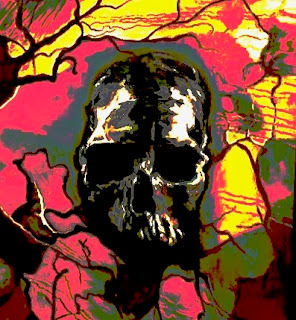
I’m delighted to have an essay published today in Paper Dragon out of Drexel University. “Poking Death’s Boundary” explores our fascination with horror movies, cemeteries, walking with grief, and dancing with death like a distant cousin.
https://drexelpaperdragon.com/poking-...
(The artwork above is by Martha Liebenow.)
November 9, 2024
Respect and Responsibility

Nurturing Compassion for All Creation
When someone or something we love dies, we grieve.
Right now, half of the country is angry and the other half seems to be gloating.
(Much of this post is something I first published on October 6, 2017.)
In Lauret Savoy’s essay, “The Future of Environmental Essay,” published by Terrain Magazine, she says there are two words we need to remember when we interact with other people, other cultures, and the land: respect and responsibility.
Each of us carries a community inside us. The history of all who came before us — our ancestors — are held within us. Our lives are rooted in their past, and we carry remnants of what they went through, the trauma they suffered as well as the joys and celebrations.The home we grew up in is an environment as much as the forests, meadows, and rivers that live around us. Our neighborhood is an environment, as well as the rest of the city. The weather and the seasons are part of us, shaping our outlook and modulating our moods. For example, if we love warm sunshine, when it’s cold and rainy for a week, we become negative.
Respect yourself and others.
We can lose sight of our values, both personal and communal, under the grind and stress of everyday chores and social discord.
With all that we have to do to just get through each day, we may not think we have the time to consider the long-range implications of what we do, how our choices affect other people, or how they harm the land. It is helpful if we take a few moments every morning to be quiet and remember our values so that they can guide our actions and decisions throughout the day.
Respect other people and listen to them. They have a right to their views as much as you do. Make decisions together. Collective wisdom is greater than individual hubris.
Respect the land and take responsibility for your actions.
In the news, another large earthquake shook Oklahoma in an area where they never used to have earthquakes. The cause has been identified as fracking. In Ohio and Pennsylvania, drinking water for cities has been polluted by the industrial wastewater being injected into the ground. Those who are making money off of fracking say it causes no problems. Will the politicians and business people who profit from fracking take responsibility and pay for the damage and illnesses that fracking is causing? If we are shareholders in an oil company that fracks, but we say nothing against it, then we are guilty of causing the damage.
In North Dakota, an oil pipeline is shifted away from Bismarck because its largely white population worried that an oil leak would pollute its drinking water. The new route now goes by the water supply for Native Americans. The powerless are taken advantage of, and another treaty is broken by the United States. The oil company says the pipeline is safe, but then why move it away from Bismarck? And why has this pipeline already sprung a leak?
Respect people and your communities.
We continue to sell the lives of poor people, women, and peoples of color to make money. We belong to several communities — our family, our neighborhood, our city and nation, and the land we live on — and we have responsibilities to each of them.
We need to acknowledge our interdependence with each other and the land. We need to stop large scale exploitation and destruction of people, cultures, and the natural world.
We do not create community by putting up arbitrary boundaries of us and them, or by manipulating people for our own gain.
When death takes away someone or something we believe in, we grieve. Then we have to pick ourselves us and start over.
August 25, 2024
Living with Prostate Cancer
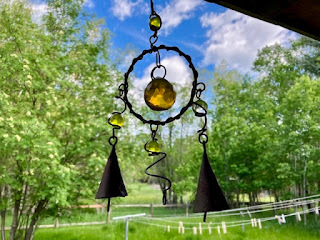
I’m nearing the two-year mark of dealing with aggressive prostate cancer, and I’ve been writing about the journey to keep my sanity. The essays that have come from this are beginning to be sent out to journals.
Both internal and external beam radiation procedures were completed last fall, but leuprolide, the androgen-deprivation drug, is still having its way with me. I think its side effects are beginning to fade a tad because my hot flashes aren’t as frequent and they aren’t as intense. The hair on my legs is still gone, as well as what I lost off my head. What muscle I have left still has no definition, and even though I exercise twice a day, I don’t see any changes there.
Because I lost strength, flexibility, and balance, I’ve begun going to yoga and Pilates classes to get them back. Most of the classes are what they call “hot,” which means that they heat up the room into the mid-90s. The idea is to sweat out all the toxins in your body. After going to classes every other day for the last two weeks, I have yet to make it through a class without needed to rest in the middle and catch my breath.
Dealing with cancer is not for the faint of heart, not that you have a choice. But I’ve experienced the grace of fellowship among cancer patients and the great compassion of the nurses and doctors.
More on all of this later.



